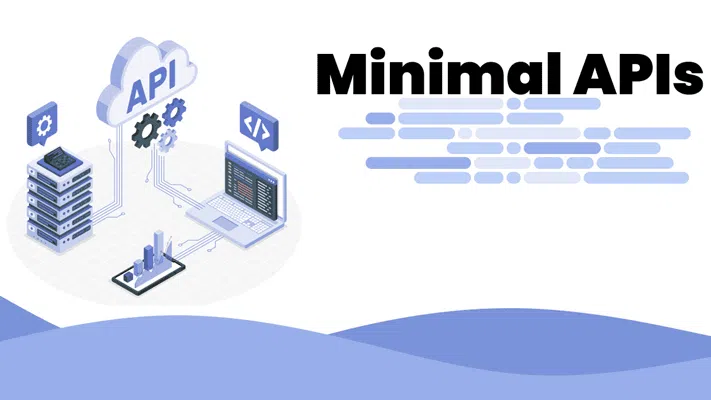Minimal API and REST API in .NET Core are two different approaches for building web APIs, each with its characteristics and use cases. Let’s delve into the differences between them:
Minimal API
Minimal APIs were introduced in .NET 6 as a way to simplify the process of creating small, focused APIs. They are designed to reduce the amount of boilerplate code required to set up an API and make the development process more streamlined. You define your routes, endpoints, and handlers in a more concise manner using the MapGet, MapPost, and similar methods.
Advantages:
- Minimal APIs are concise and require less code compared to traditional REST APIs.
- They are suitable for simple scenarios where you need to quickly create an API without a lot of complex configuration.
- Routing and handling endpoints are done using lambdas, making it easier to understand the flow of the API.
- Minimal APIs are a great choice for simple scenarios where you want to quickly expose a few endpoints without dealing with the complexities of traditional routing and middleware setup.
Disadvantages:
- Minimal APIs might not be the best choice for complex APIs with a large number of endpoints and intricate routing requirements.
- They might not provide the same level of customization and control as traditional REST APIs.
Minimal API Example:
In this example, we’ll create a minimal API using .NET 6’s minimal API approach. This example demonstrates how to create a basic endpoint that returns a “Hello, World!” message.
|
1 2 3 4 5 6 7 8 9 10 11 |
using Microsoft.AspNetCore.Builder; using Microsoft.AspNetCore.Http; using Microsoft.Extensions.Hosting; var builder = WebApplication.CreateBuilder(args); var app = builder.Build(); app.MapGet("/", () => "Hello, World!"); app.Run(); |
REST API
Representational State Transfer (REST) APIs have been the traditional way of building APIs in the web development world. They follow certain architectural principles and conventions for designing APIs that interact with resources. REST APIs are built around a set of constraints, including stateless communication, resource-based interactions (using nouns as endpoints), and a uniform interface (HTTP methods like GET, POST, PUT, DELETE).
Advantages:
- REST APIs provide a standardized way of designing APIs that is familiar to developers.
- They offer greater flexibility and customization in terms of routing, request/response handling, and middleware.
- REST APIs are well-suited for larger, more complex applications with a variety of endpoints and functionalities.
- In .NET Core, building a REST API involves configuring routes, controllers, and actions. You can use attributes to define routes and HTTP methods.
- REST APIs are suitable for more complex scenarios where you need to follow well-established patterns and conventions for building APIs that various clients can easily consume.
Disadvantages:
- Creating REST APIs might involve more boilerplate code and configuration compared to Minimal APIs.
- The learning curve for designing RESTful APIs can be steeper, especially for newcomers.
REST API Example:
Now, let’s create a REST API using the traditional approach with .NET 6. This example shows how to create a basic REST API with CRUD operations for a simple “Todo” resource.
|
1 2 3 4 5 6 7 8 9 10 11 12 13 14 15 16 17 18 19 20 21 22 23 24 25 26 27 28 29 30 31 32 33 34 35 36 37 38 39 40 41 42 43 44 45 46 47 48 49 50 51 52 53 54 55 56 57 58 |
using Microsoft.AspNetCore.Builder; using Microsoft.AspNetCore.Http; using Microsoft.Extensions.DependencyInjection; using Microsoft.Extensions.Hosting; using System; using System.Collections.Generic; // Todo model public class Todo { public int Id { get; set; } public string Title { get; set; } public bool IsCompleted { get; set; } } // TodoRepository for storing todos public class TodoRepository { private List<Todo> _todos = new List<Todo>(); public IEnumerable<Todo> GetAll() => _todos; public Todo GetById(int id) => _todos.FirstOrDefault(todo => todo.Id == id); public void Add(Todo todo) { todo.Id = _todos.Count + 1; _todos.Add(todo); } // Other CRUD operations can be added here } var builder = WebApplication.CreateBuilder(args); builder.Services.AddSingleton<TodoRepository>(); var app = builder.Build(); app.MapGet("/todos", (TodoRepository repository) => repository.GetAll()); app.MapGet("/todos/{id}", (int id, TodoRepository repository) => { var todo = repository.GetById(id); if (todo == null) { return Results.NotFound(); } return todo; }); app.MapPost("/todos", (Todo todo, TodoRepository repository) => { repository.Add(todo); return Results.Created($"/todos/{todo.Id}", todo); }); app.Run(); |
Key Considerations:
- Complexity: Minimal APIs are simpler to set up and use, making them ideal for small projects or simple APIs. REST APIs provide more structure and features for complex scenarios.
- Flexibility: REST APIs offer more customization options in terms of middleware, error handling, and request/response processing. Minimal APIs, on the other hand, are more opinionated in their approach.
- Conventions: REST APIs often follow established naming conventions and principles for resource management, making them familiar to developers who are used to working with this style.
-
Migration: If you’re already experienced with REST APIs and want to migrate to Minimal APIs, you might need to adjust your mindset and refactor some code. However, the transition is relatively straightforward for simpler APIs.
Choosing Between Minimal API and REST API
Choosing between Minimal APIs and REST APIs depends on the complexity and requirements of your application:
-
Use Minimal API When:
- You need to create a simple API with minimal setup quickly.
- Your API has a limited number of endpoints and straightforward routing.
- You prefer a more streamlined and code-light approach.
-
Use REST API When:
- Your API is complex and has a large number of endpoints.
- You need fine-grained control over routing, request/response handling, and middleware.
- You want to follow established RESTful principles and patterns.
In summary, if you’re building a small and simple API, Minimal APIs can be a great choice due to their reduced code overhead. However, for larger and more complex applications, a traditional REST API might offer more flexibility and control. Always consider the specific requirements of your project when making this decision.






Leave a Comment